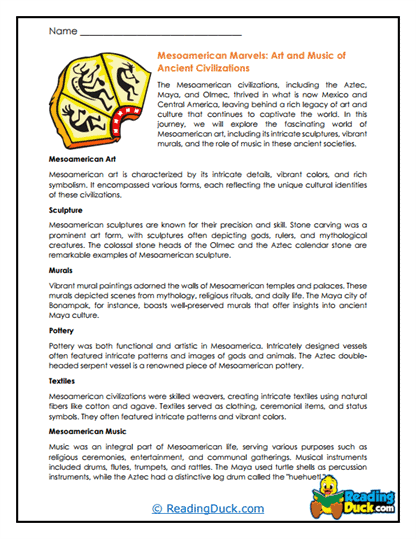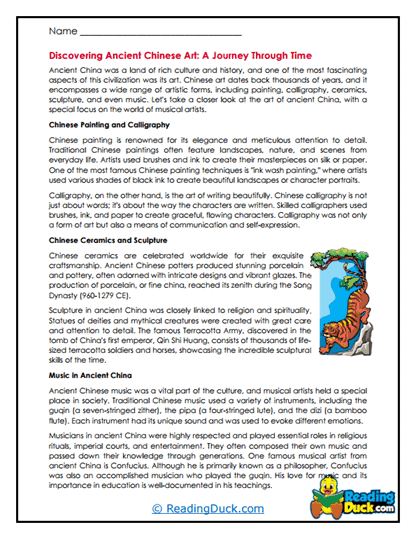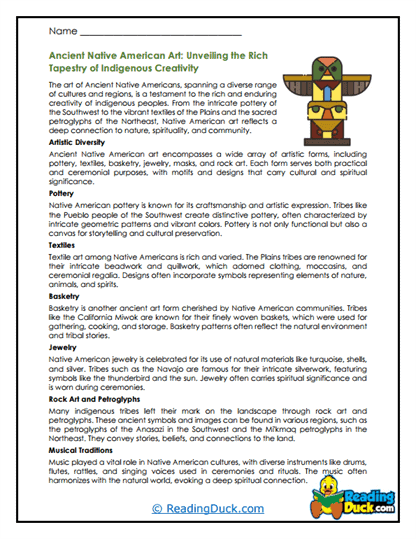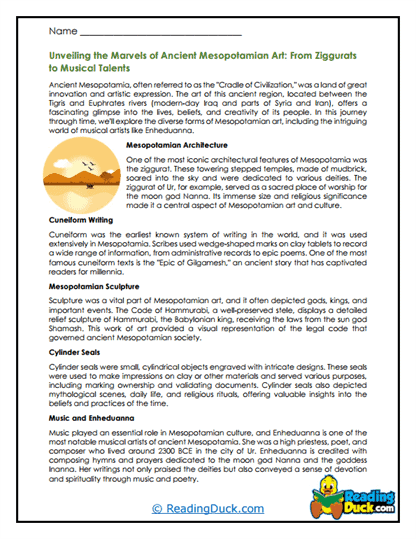Ancient Art Worksheets
About Our Ancient Art Worksheets
Our Ancient Art Worksheets offer an immersive and educational journey through the rich history of early human creativity and expression. Designed to engage students with the wonders of ancient civilizations, these worksheets cover various aspects of ancient art, including iconic works and the cultural contexts in which they were created.
Each worksheet set includes:
- Multiple Choice Questions: These questions assess students' comprehension of the reading passages, focusing on key details, historical facts, and the significance of specific art forms or artists.
- Short Answer Questions: Students are asked to provide concise responses, summarizing important information, analyzing the elements of ancient art, and reflecting on its historical impact.
- Open-Ended Questions: These questions encourage students to think critically and express their personal interpretations, opinions, and preferences regarding ancient art, allowing for deeper engagement with the material.
These worksheets help students demonstrate their understanding of ancient art and foster a meaningful connection to the subject matter. An answer key is provided for each question sheet, making it easy for teachers and parents to evaluate student progress. The worksheets are available in PDF format, ensuring they can be easily viewed electronically, downloaded, and printed.
Exploring the World of Ancient Art: A Glimpse into the Past
Ancient art provides a fascinating window into the lives, beliefs, and cultures of early civilizations. Through their artistic creations, ancient peoples communicated their stories, values, and connections to the divine, leaving behind a legacy that continues to inspire and educate us today. Understanding ancient art is essential for appreciating the development of human creativity and the ways in which art has shaped and been shaped by societies throughout history.
Students exploring ancient art will delve into several key aspects:
- Cultural Significance: Ancient art was deeply intertwined with the cultures that produced it. Whether through religious rituals, political power, or social customs, art played a crucial role in conveying the values and beliefs of ancient societies. Students will explore how art was used to communicate messages, celebrate achievements, and honor the gods.
- Iconic Works and Monuments: Ancient art is renowned for its iconic works and monumental structures, such as the pyramids of Egypt, the Parthenon in Greece, and the intricate pottery of the ancient Chinese. These masterpieces not only showcase the technical skills of their creators but also provide insight into the cultural and historical contexts in which they were produced.
- Artistic Techniques and Materials: The study of ancient art also involves an exploration of the techniques and materials used by ancient artists. From the use of natural pigments and stone carving to metalworking and fresco painting, students will learn about the diverse methods employed by artists to bring their visions to life.
- Symbolism and Mythology: Many ancient artworks are rich with symbolism and mythology, reflecting the spiritual and philosophical beliefs of their creators. Students will investigate the meanings behind the symbols and stories depicted in ancient art, gaining a deeper understanding of how art was used to convey complex ideas and emotions.
- Evolution of Artistic Styles: Over time, the artistic styles of ancient civilizations evolved, influenced by cultural exchanges, technological advancements, and changing societal needs. Students will trace the development of these styles, from the stylized figures of early Mesopotamian art to the naturalistic forms of classical Greek sculpture.
By studying ancient art, students will not only gain an appreciation for the artistic achievements of early civilizations but also develop a broader understanding of the historical forces that shaped human culture.
How Teachers and Parents Can Integrate These Worksheets in a Learning Curriculum
Integrating the study of ancient art into a learning curriculum can be an enriching experience for students, offering them a deeper understanding of history, culture, and the development of human creativity. Here are some practical ideas for using these worksheets in the classroom or at home:
- Create a Timeline of Artistic Development: Use the worksheets to help students create a timeline that traces the development of ancient art across different civilizations. This activity can help students understand the chronological progression of artistic styles and how they influenced one another.
- Connect Art with History: Integrate the study of ancient art with history lessons, showing how artistic developments were often influenced by historical events, such as the rise and fall of empires or the spread of religious movements. This cross-disciplinary approach can deepen students' understanding of both subjects.
- Group Discussions and Presentations: Encourage students to work in groups to research a particular civilization's art, using the worksheets as a foundation. They can then present their findings to the class, fostering collaboration and public speaking skills.
- Art Replication Projects: After learning about specific techniques and styles from the worksheets, have students create their own artwork inspired by ancient techniques. This hands-on activity helps students connect with the material in a tangible way.
- Field Trips or Virtual Tours: If possible, organize field trips to museums with ancient art collections or use virtual tours to explore famous ancient art sites. These experiences can provide context and make the subject matter more relatable and engaging for students.
- Supplemental Homework Assignments: Use the worksheets as supplemental homework assignments to reinforce in-class learning. Students can complete the reading passages and questions at home, allowing for more in-depth exploration of the topic.
- Incorporate Technology: Encourage students to use online resources to research additional information about ancient art. They can explore virtual museum exhibits or create digital presentations to complement the worksheets.
- Tailor to Different Learning Levels: Adapt the complexity of the worksheets to suit different grade levels. For younger students, focus on basic concepts and simpler art forms, while older students can handle more detailed analyses of artistic techniques and historical contexts.
Studying ancient art through these worksheets can enhance students' critical thinking, analytical, and interpretative skills. By engaging with the art of ancient civilizations, students develop a greater appreciation for cultural diversity and historical significance, which are essential for their overall academic and personal growth. These skills not only contribute to success in the classroom but also foster a lifelong interest in history and the arts, encouraging students to explore and appreciate the world around them.









